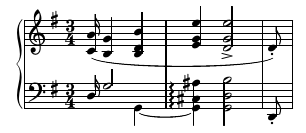Chopin's Mazurkas - Part 7
I was planning to cover the guitar solo from Days of the New's Touch, Peel and Stand, but I'm in the process of migrating my recording computer to a more powerful laptop, and also switching from Xubuntu to Ubuntu Studio, and it has not gone as swimmingly as I had hoped. So most of this week was spent debugging Ardour crashes and buying USB hubs with a power supply.
So I'm going to do what I always do in these situations: give up and listen to more mazurkas. Luckily there are only three in Opus 50, so I can smash through them in the next 24 hours and not feel like a loser for missing a week.
Trois Mazurkas
For à Mr. Léon Szmitkowski.
Op. 50, No. 1 in G major
Some interesting passing tones in the A section here. Very minuet-like.
After repeating the A/B sections twice there's a very abrupt modulation to C minor as the left hand takes over the melody.
Some kind of neat diminished triads lead into the Coda involving the
iv (C minor). Like a Picardy third variation. I'm sure
there's a music theory name for it.
Op. 50, No. 2 in A♭ major
A slow and subtle lead in reminded me of the intro to Chopin's 3rd Ballade. But there aren't really any similarities beyond starting on the same note in the same key.
This mazurka strikes me as kind of a cross between a Waltz and a Nocturne. It's got the Waltz meter and rhythm but it's kind of melancholy, like many of his nocturnes. And then it modulates to D♭ and now it's a Polonaise. And of course it just repeats for a while, in case you forgot it was actually a mazurka.
This was very pleasant and nice, and actually looks like it might be fun to play.
Op. 50, No. 3 in C♯ minor
I really like the intro on this piece. Kind of a call-and-response
between left- and right- hands, featuring my favorite V
of the V stuff, of course. And then it ruins it by
just blindly repeating.
Then comes some Polonaise-like pounding on the keyboard, which is followed up with some truly beautiful left-hand phrasing.
The C section modulates to the V in B major. This section ends
with a nice transition to G♯ which leads back to the intro/A section
motif in C♯ minor. This intro motif is expanded into what appears to
be a four-voice fugue. It sounds very cool. Probably hard to play, though.
Some interesting ascending chord pregressions in the D section (or whatever). Rachmaninoniff basically ripped off this chromatic technique in every one of his concertos.











